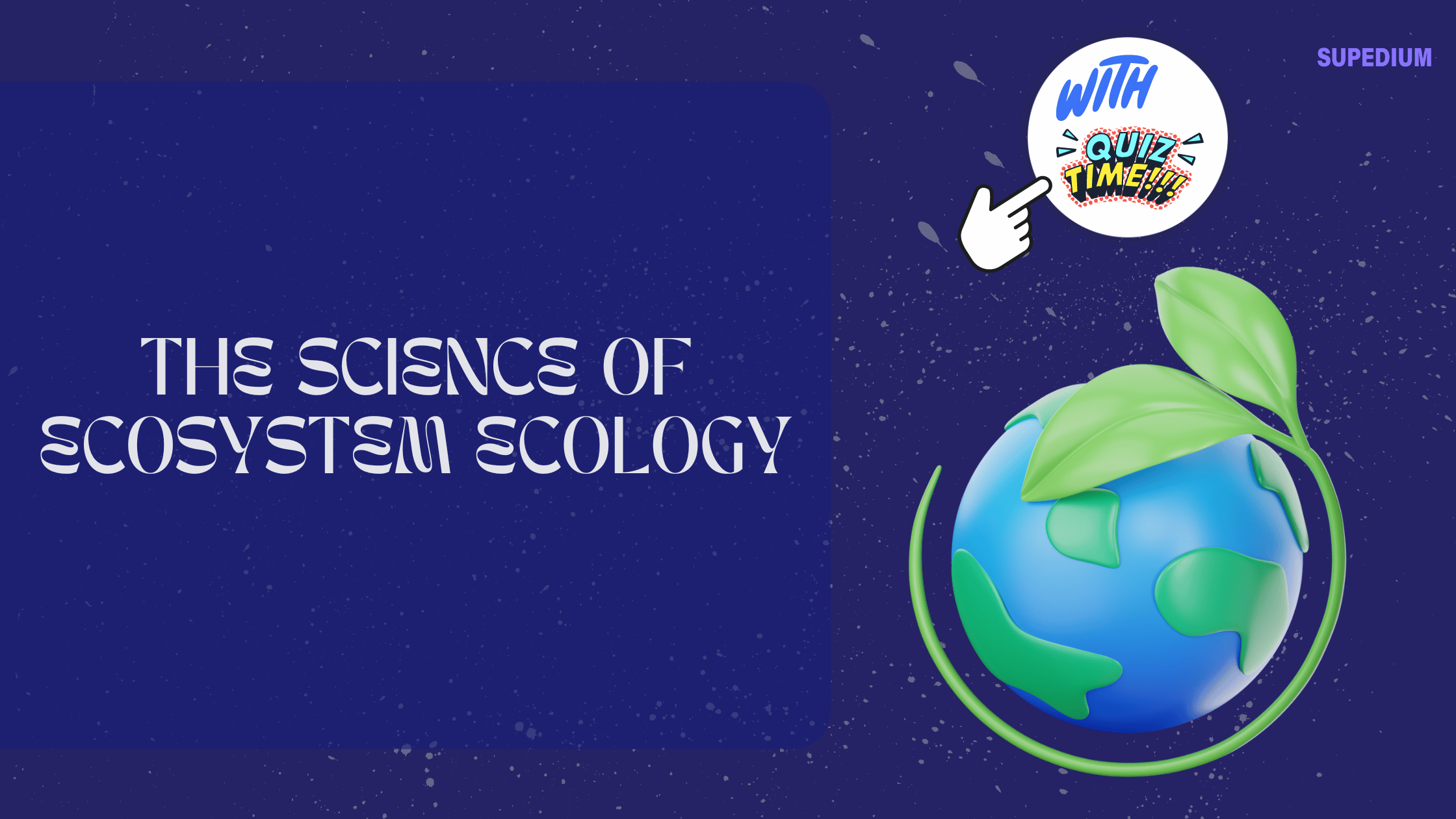Table of Contents
- 0.1 Introduction to Ecosystem Ecology
- 0.2 Core Concepts in Ecosystem Ecology
- 0.3 Ecosystem Dynamics and Interactions
- 0.4 Ecosystem Types and Characteristics
- 0.5 Human Impacts on Ecosystems
- 0.6 Methods and Tools in Ecosystem Ecology
- 0.7 Applications of Ecosystem Ecology
- 0.8 Future Directions in Ecosystem Ecology
- 0.9 Conclusion
- 1 Quiz Time
![]()
Ecosystem ecology is a crucial field of study that delves into the intricate interactions between living organisms and their physical environment. This branch of ecology emphasizes the flow of energy and the cycling of nutrients within ecosystems, providing a comprehensive understanding of how ecosystems function and sustain life. In this article, we explore the core concepts, dynamics, types, human impacts, methods, applications, and future directions of ecosystem ecology.
Introduction to Ecosystem Ecology
Definition of Ecosystem Ecology
Ecosystem ecology is the study of the relationships between organisms and their environments, focusing on how energy flows through ecosystems and how nutrients are cycled. It combines biological, chemical, and physical perspectives to understand the interactions within and between ecosystems.
Importance of Ecosystem Ecology
Understanding ecosystem ecology is vital for several reasons. It helps us appreciate the ecosystem services that support life, such as clean water, air purification, and nutrient cycling. It also plays a critical role in addressing environmental challenges like climate change, habitat loss, and biodiversity decline.
Historical Background
Ecosystem ecology has evolved from early ecological studies that observed natural environments to more complex theories involving energy flow and nutrient cycling. Key developments include the introduction of the ecosystem concept by Arthur Tansley in 1935 and the expansion of ecological models and methods in the following decades.
Core Concepts in Ecosystem Ecology
Ecosystem Structure
The structure of an ecosystem consists of both abiotic and biotic components.
- Abiotic Components: These are non-living factors that influence the ecosystem, including climate (temperature, precipitation), soil characteristics, and water quality.
- Biotic Components: These include living organisms categorized into producers (autotrophs), consumers (herbivores, carnivores, omnivores), and decomposers (detritivores, saprotrophs).
Energy Flow in Ecosystems
Energy flow through ecosystems follows a pathway from primary producers to various levels of consumers:
- Primary Production: This includes Gross Primary Productivity (GPP), the total amount of energy captured by photosynthesis, and Net Primary Productivity (NPP), the energy available to herbivores after accounting for plant respiration.
- Trophic Levels and Food Webs: Organisms are organized into trophic levels based on their role in the food web. Energy transfer between levels is inefficient, with significant energy loss at each step.
Nutrient Cycling
Nutrient cycling involves the movement of essential elements through the ecosystem:
- Carbon Cycle: Carbon is exchanged between the atmosphere, organisms, and the environment through processes like photosynthesis, respiration, and decomposition.
- Nitrogen Cycle: Nitrogen is converted between various forms, including atmospheric nitrogen, ammonia, nitrate, and organic compounds, involving processes such as nitrogen fixation and denitrification.
- Phosphorus Cycle: Phosphorus moves through soil, water, and organisms, primarily through processes like weathering, uptake by plants, and return to the soil through decomposition.
Ecosystem Dynamics and Interactions
Ecosystem Succession
Ecosystem succession is the process of ecological change over time:
- Primary Succession: Occurs in lifeless areas where no soil exists, such as lava flows or glacial retreats. Pioneer species gradually build soil, allowing for more complex communities to develop.
- Secondary Succession: Takes place in areas where an existing ecosystem has been disturbed but soil remains, such as abandoned farmland or after a forest fire. This process typically progresses more quickly than primary succession.
Resilience and Stability
Ecosystem resilience refers to the ability of an ecosystem to recover from disturbances and maintain its essential functions. Factors affecting resilience include biodiversity, the complexity of food webs, and the availability of resources.
Disturbance and Recovery
Ecosystems are subject to disturbances, both natural (e.g., wildfires, hurricanes) and anthropogenic (e.g., deforestation, pollution). The ability of ecosystems to recover from these disturbances depends on their resilience and the nature of the disturbance.
Ecosystem Types and Characteristics
Terrestrial Ecosystems
- Forests: Include tropical rainforests, temperate forests, and boreal forests, each with distinct climate conditions, vegetation types, and biodiversity levels.
- Grasslands: Encompass savannas and prairies, characterized by open landscapes with grasses and few trees, adapted to periodic fires and grazing.
- Deserts: Defined by extreme dryness and sparse vegetation, deserts have adapted species and processes to conserve water.
Aquatic Ecosystems
- Freshwater Ecosystems: Include lakes, ponds, rivers, and streams, with varying levels of productivity and biodiversity based on nutrient availability and flow dynamics.
- Marine Ecosystems: Comprise coastal zones, open ocean, coral reefs, and estuaries. These systems are characterized by saltwater, complex food webs, and diverse habitats.
Human Impacts on Ecosystems
Habitat Destruction and Fragmentation
Human activities, such as urbanization and agriculture, lead to habitat destruction and fragmentation, disrupting ecosystems and threatening biodiversity.
Pollution
Pollution affects air, water, and soil quality, leading to adverse effects on ecosystem health. Pollutants can disrupt nutrient cycles, harm wildlife, and degrade ecosystem services.
Climate Change
Climate change alters temperature and precipitation patterns, impacting species distribution, ecosystem processes, and the frequency of extreme weather events. These changes can lead to shifts in ecosystems and loss of biodiversity.
Invasive Species
Invasive species are non-native organisms that can outcompete native species, disrupt ecological processes, and cause economic damage. Managing invasive species is crucial for maintaining ecosystem balance.
Methods and Tools in Ecosystem Ecology
Field Studies
Field studies involve direct observation and experimentation in natural settings to understand ecosystem dynamics, species interactions, and environmental processes.
Remote Sensing and GIS
Remote sensing and Geographic Information Systems (GIS) provide valuable tools for monitoring and analyzing ecosystem characteristics, land use changes, and environmental conditions from a distance.
Modeling Ecosystems
Ecological models simulate ecosystem processes and interactions to predict responses to various scenarios. These models can help in understanding complex systems but have limitations in accuracy and precision.
Applications of Ecosystem Ecology
Conservation and Management
Ecosystem ecology informs conservation strategies and resource management by highlighting the importance of preserving biodiversity and maintaining ecosystem functions.
Restoration Ecology
Restoration ecology focuses on restoring degraded ecosystems to their natural states. It involves applying principles of ecological succession and understanding local conditions to guide restoration efforts.
Policy and Decision Making
Ecosystem services valuation and ecological research support the development of environmental policies and decisions aimed at sustainability and resilience.
Future Directions in Ecosystem Ecology
Emerging Research Areas
Future research in ecosystem ecology includes studying climate change adaptation, integrating ecosystem services with human well-being, and understanding the impacts of emerging threats.
Advances in Technology and Methods
Technological advances, such as big data analytics and improved ecological modeling, will enhance our ability to monitor ecosystems and predict future changes.
Interdisciplinary Approaches
Collaboration with social sciences and policy makers will be essential for addressing complex environmental challenges and promoting sustainable development.
Conclusion
Ecosystem ecology provides a foundational understanding of how ecosystems operate and interact with their environment. By studying the flow of energy, cycling of nutrients, and impacts of human activities, we gain insights that are crucial for managing and conserving our natural world. As we face global environmental challenges, the knowledge and applications of ecosystem ecology will be vital in guiding our efforts toward a sustainable future.






Be the first to comment